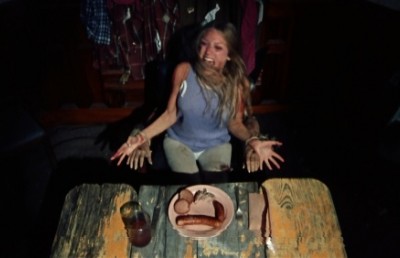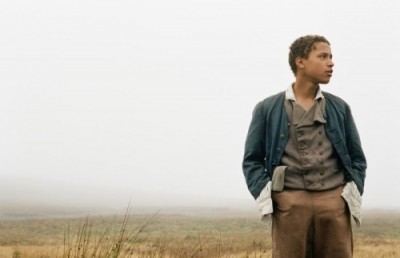Far From Heaven and Carol: Channeling 1950s Melodrama
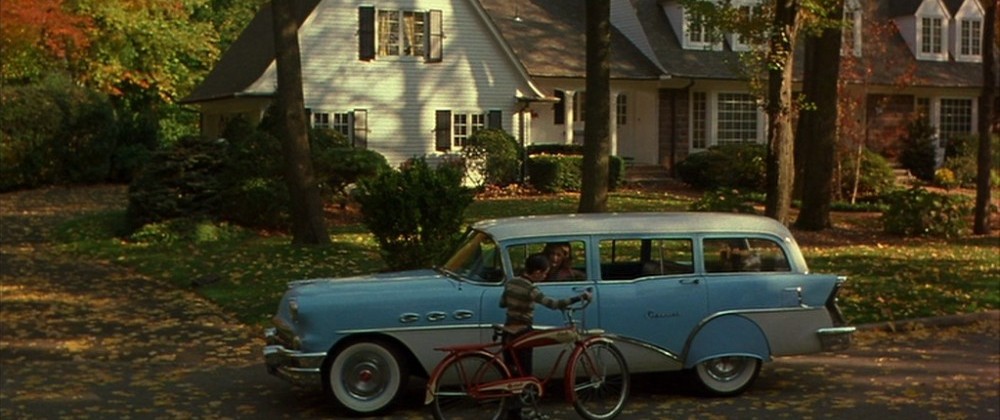
For purposes of scene access I have placed time codes (in minutes: seconds) next to descriptive passages, in case a reader feels the urge to view the scene in question.
Far From Heaven (2002) and Carol (2015), directed by Todd Haynes, treat a similar theme of female oppression characteristic of the 1950s time period the two films are set in. The films also share many aspects of visual style distinctive to the melodrama, which portrays mundane and ordinary families, revealing female characters that not only resist hindrance to their freedom and desires, but also struggle with their emotions. In Far From Heaven, a husband’s secret desire for men is paralleled with his wife’s interracial relationship with their gardener. In Carol, a young sales clerk on the path of self-discovery has a forbidden homosexual love affair with a wealthy and discontented suburban wife. These films cultivate a friction “between interior emotions and exterior restrictions, between yearning or loss and satisfaction and renewal” (Corrigan and White 327). They simultaneously deal with issues surrounding sexuality, gender, class, and race, where the ideal family serves as a form of repression. Looking specifically at these themes, I will discuss how Haynes, through style, uses key aspects from the melodrama genre to depict the confinements of the 1950s.
The 1950s is a time of constraining expectations; everyone is expected to lead perfect suburban lives, and those that deviate are socially condemned. Haynes sets this up in Far From Heaven, where Cathy appears to have a model life: two children, a successful husband, and a suburban home. She is a typical housewife, admired by others: “Women just like yourself, with families and homes to keep up” (Mrs. Peacock). This is dismantled in the premise, when Cathy receives a call from the police station regarding her husband. Beauty and perfection, here, are forms of oppression. The props are also important to observe as symbols of the 1950s: the television manifests the suburban prosperity that characterizes the time period. Cathy must adhere to the narrow and confining gender roles of the 1950s, just as Frank must suppress his homosexual desires. These characters, disillusioned in their seemingly flawless worlds, ultimately find these symbols as oppressive. To create a realistic melodramatic setting, Haynes takes inspiration from Sirk’s world of artifice, making every aspect of the film stylistic of the 1950s. Higgins points out that Haynes organizes his palette around two sets of contrasts: cool/warm tones, and red/green tones. These are carried out throughout the film, as well as seasonal structure (104). Blue is a recurrent color that represents loneliness, repression and oppression for both Frank and Cathy. The colors and shadows show a real disconnection present in Cathy’s life. The use of wide angles allows the viewer to observe everything; as such, characters are unable to escape the vantage point of the camera. This suggests how trapped they are not only within their environment, but also within society. This is also true for Carol: the characters are often restricted to the frame, as they are filmed through doorways and only partially viewed. The crane shots at the opening and ending scenes of Far From Heaven establish the setting and unveil a feeling of distance (Corrigan and White 112). The dialogue also corresponds to the time period, with the use of words that are no longer common today: “swell”, “aw geez!” Several times in the film, Cathy, absorbed in her thoughts, is surprised with a sudden flash of the camera (39’05”). This is perhaps a reminder that she is constantly being scrutinized, and must continuously conform to social standards. Cathy’s seemingly perfect life is further taken apart as a gradual disconnection from the men in her life grows. In one scene, she is positioned on the same side as her maid, with her son and husband on the other side of the frame (81’03”). Perhaps this suggests her empathy for the underprivileged, which her community, and even her closest friend, eventually condemns her for. Frank is also outraged by her relationship with Raymond, saying, “don’t you realize the effect that this could have on me and the reputation I have spent the past eight years trying to build for you and the children and for the company?” (61’49”)
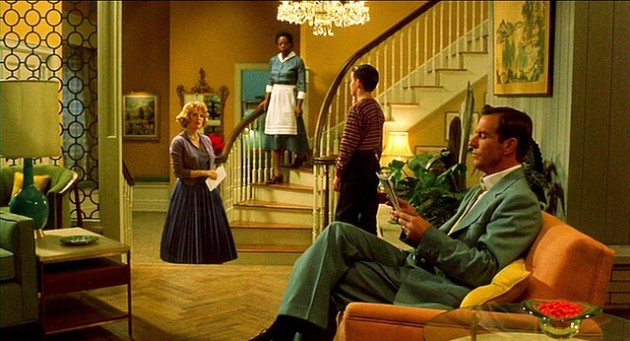
Domestic bliss stylized to exaggerated perfection
The more recent Carol also takes place in the 1950s. Haynes, inspired by older films, uses similar context, but brings new and modern pressing issues of this time period. As highlighted by Andrade, the agony and trauma the protagonists face in Carol is a familiar theme found in melodrama films of the 1940s and 1950s. While the film maintains many of the genre’s conventions, it introduces new forms of oppression and love. To ensure its authenticity, Haynes shot in 35mm, embracing the film grain. The opening scene is symbolic of the imprisonment experienced by women in the 1950s. As the credit rolls, there is a close-up on the metal metro gates, where the title of the film appears translucent behind the bars. This suggests the confinement experienced by the heroines throughout the film (1’05”).
Sexuality is perhaps the most important theme found in both films. During the 1950s, homosexuality was unthinkable and unusual; the imposed social conventions prevented individuals from leading authentic lives. This taboo is cinematically depicted by Haynes, who uses unnatural and bright lighting. Green lights appear as Frank experiences his homosexual desires (16’50”). In Far From Heaven, the green also appears when Cathy catches him in his office kissing another man (24’43”). During their trip to Miami, the lights change from blue to green when Frank catches the eye of a man (75’15”). He continuously fights his homosexuality, treating it like a disease: “I can’t let this ‘thing’ destroy my life, my family’s life. […] I know it’s a sickness” (31’13”). Frank tries to conform by being intimate with his wife, but he is unable to betray his true nature. Running away from his life in Hartford, he is nevertheless unable to suppress his homosexuality, ultimately accepting his true self. As he cries, the children’s role model for strength and solidity is destroyed. The camera slacks to her (84’35”) as she comes to the realization that her life is permanently shattered. Perhaps still restrained by societal norms, she maintains strong character. In both films the protagonists travel: in Carol, they are attempting to escape societal pressures; in Far From Heaven, Frank is escaping his true self. Ultimately, these trips are unsuccessful.
While the lighting in Carol is more naturalistic than Far From Heaven, green appears as the women escape New York (32’40”). The notion of homosexuality as an illness is also reflected in Carol, which Carol is expected to “recover” from. According to Andrade, Carol has the classic melodrama aspect of having women as protagonists stuck in a suburban life. However, there is a modern twist of forbidden love, not only because it is adulterous, but also because it is homosexual. Confined by the expectations of the 1950s, Carol and Therese struggle with their emotions. Andrade observes a key motif that appears throughout the film: a car window. “The line between the world of the film and the world of film is also seen through this rain drop-covered window, rendering it uneven, distorted and imprecise.” In other words, this car window contextually frames both the film and Therese, encompassing both a time and place within the film and within the history of film. This motif, does, in fact, appear consistently throughout the film. This perhaps symbolizes entrapment by social conventions and norms. Towards the end of the film, we see Therese confined in a car full of men. She is, once again, staring out of this raindrop covered glass window as she longs for an escape from this confinement. When Carol and Therese are together in the car, away from societal pressures, the camera is still positioned behind the car window. Perhaps the window symbolizes the impediment that prevails: Carol’s husband. The characters of the film are stuck in a society that not only demands that they, as women, perform certain roles they are not respecting, but also ridicules and rejects their true nature. Richard, Therese’s boyfriend, dismisses the legitimacy of this love affair, calling it a “silly crush.” Through these frames, the audience identifies with Therese; her subjectivity is focalized in the film’s framing narrative, where the story’s emotions emerge. We follow her along as she discovers and explores herself and her sexuality. She begins to evolve through her photography. While at first too timid to photograph anything beyond her environment, fearful it would be an invasion of privacy, she begins to photograph Carol, perhaps embracing her love for her.
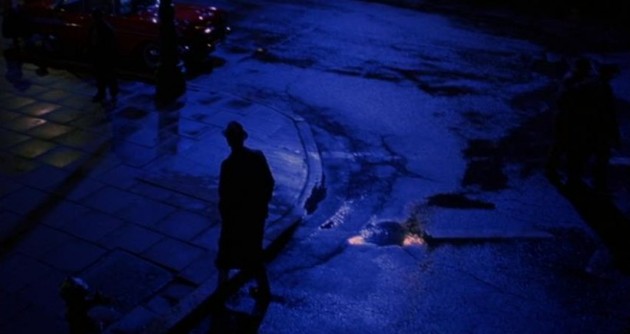
The dangerous noirish world of homesexuality
A theme that is often found in melodramas is that of forbidden love, where two individuals of different statuses mix worlds. In Far From Heaven, Cathy’s growing bond with her black gardener is condemned; in Carol, Carol’s desire for Therese is disapproved. Bigotry and racism was predominant in the 1950s. Blacks were of lower status, so whites did not associate with them. We can clearly observe this intolerance when Cathy and Frank are in Miami: a little black boy jumps into the pool, and everyone exits. This intolerance is what causes Raymond and Cathy’s relationship to be outrageous, and therefore impossible in their setting. Here, there is a clear relationship between emotion and nature. Throughout the film, we can observe that Cathy and Raymond’s meaningful encounters are outside, often in gardens. Their environment reflects their ability to express emotions. In fact, Cathy repeatedly admits that Raymond makes her feel alive. She can talk to him like she can’t talk to anyone else, creating a connection with him that she never had with her husband, who never remembers her carpool days (96’03”). The interactions that occur inside are accompanied with judgment. The presence of nature could suggest that their desire for each other is not unnatural. When her purple scarf blows to the gardener, we can observe an extreme overhead shot (18’50”). This suggests freedom and her desire to be unconstrained. It shows once again that there is an undeniable force of nature between them. In fact, it seems that nature is making a decision for her, as if she is destined to be with him. Nature appears once again when she brings a plant he gifted her into the house, implying she is accepting him into her life (61’43”). Nevertheless, she still faces judgment from the community. At the art show, all attendees are gawking and gossiping; at her daughter’s dance recital, the mothers look down at Cathy, protecting their children from her ‘unacceptable’ behavior. However, his judgment is not specific to her white community; in fact, no matter their environment, whether in predominantly black or white settings, the discerning looks continue. The green light that appears as they begin to dance continues the motif of strangeness. Forced by social pressures, Cathy meets with Raymond to declare the end of their relationship. Covered in a ‘shell’ of clothes, the way she dresses does not reflect her real emotions. Raymond admits that he wishes “maybe that for one fleeting instant [she] could manage to see beyond the surface, beyond the color of things” (71’30”). Ironically, the movie theater they stand by is showing “The Bold and the Brave”; perhaps this refers to them going against social norms. The dolly shot encases a sense of loss, tragedy, and sadness, as both Raymond and Cathy are repressing their love for each other.
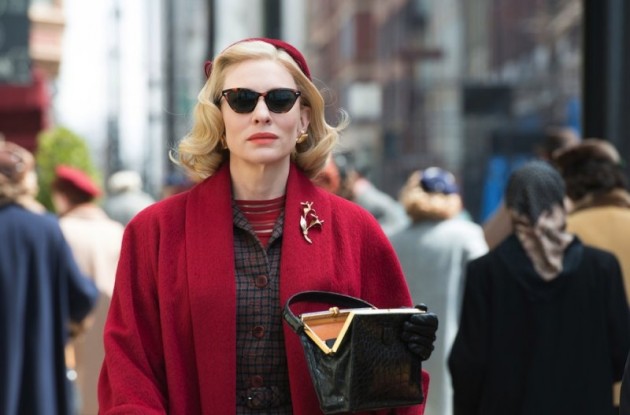
Elegant sheek camouflaging discontent
While their sexuality is what causes their love to be forbidden, class and age are important aspects in Carol and Therese’ relationship. Carol embodies the wealthy and discontented suburban wife; beautiful and elegant, her wealth is shown through her car, her fur coat, and her pearls. Separately, Therese is on the path of self-discovery, unsure and indecisive until she meets Carol: “I don’t know anything and I don’t know what I want” (81’55”). A working-class sales clerk, she searches for something that defines her, coming across photography. During their first ‘date’, Carol brings Therese to an elegant restaurant. Unfamiliar and unsure of her environment, she orders what Carol does: “I barely even know what to order for lunch” (22’14”). Here, we can clearly notice how out of place she feels, further deepening their class differences. The characters are also separated by age, as underlined by Carol: “I never looked like that” (76’11”), “You seek resolutions and explanations because you’re young. But you will understand this one day” (87’54”). Therese also seems childlike, resembling Carol’s daughter in her mannerisms and style. Carol brushes her hair and does her makeup, as she does with her daughter. In melodramas, the audience often sees the story unravel through the eyes of the most vulnerable character. This explains why Haynes repeatedly takes Therese’s subjective view (112’49”). Carol ultimately becomes the more vulnerable character, more liable to be hurt. Similar to Far From Heaven, the lovers must release each other because of social pressures.
Women, fantasy, and excess are characteristic of melodramas. These elements are found in both of Haynes’ films. The excessive lighting and autumnal warmth in Far From Heaven is not justified by a diegetic source; therefore, it is not realistic. The excess music found in both films powerfully conveys emotions, as melodrama is “a combination of the intensities of music (melos) and the interaction of human conflicts (drama)” (Corrigan and Patricia 326). The same songs are repeated diegetically throughout the films, conceiving a fantasy world for women. Haynes shows his deep interest in creating films driven by women: “I’m pleased if I’m doing anything to reinvigorate a discussion in movies about women’s stories, women’s status, and women’s experiences—and also, stories that aren’t by definition affirmative or heroic. My films […] raise questions about our lives, and about choices we do or do not have” (Davis 35). Focusing on its elements of fantasy and excess, signature to woman’s film, White observes that fantasy operates not only in the sense of daydream, but also as a “mise-en-scène of desire” (11). Haynes’ constant revisitation to the past in his films, particularly to women’s situation in the pre-feminist era, is especially important, as fantasy plays a historically specific role. Melodrama prioritizes strong emotional response, often made for women. DeFalco defines melodrama as a “mode commonly defined by its incitement of strong feeling through sensationalism, its power to inspire bittersweet tears of identificatory remorse” (32). The narrative, mise-en-scène, composition, and camera movement in both of these films are all conventional melodrama references. As 1950s woman’s films often involve excess and exaggeration, Haynes embraces it, “creating a color score that classically emphasizes and punctuates drama, at the same time […] remains marked as artificial” (Higgins 104). In the end of Far From Heaven, Haynes uses subjective shots to create a sense of loss with the recessional movement as the train leaves. The crane shot is similar to the beginning: the viewer could interpret this repetition as closure, or perhaps a renewed life. It is similar to Carol in this way, where the ending remains uncertain. The flowers signify a sign of hope in a dark world (102’41”).
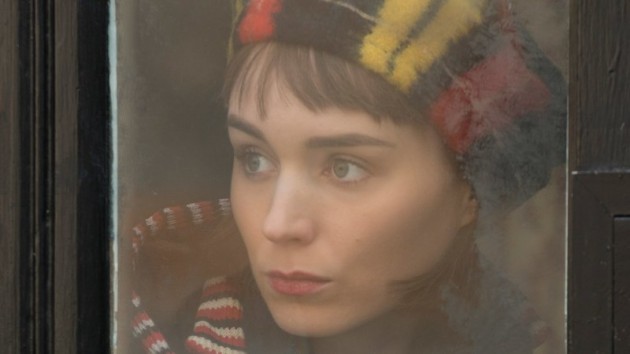
Melodrama as a mise en scene of confinement
In conclusion, Todd Haynes’ melodramas reach people’s emotions through the use of excess style. This was a time period of societal limitations for women, who faced perpetual social and domestic oppression. Haynes plays heavily on this scrutiny, examining illicit affairs that denounce the constraining social customs of the 1950s America. Evoking issues of race, class, sexuality, and age, these films depict the struggles of conforming to inflexible social standards.
A video essay by Catherine Grant that compares the openings of Far From Heaven and Douglas Sirk’s 1955 All That Heaven Allows
All That Pastiche Allows from Catherine Grant on Vimeo.
Works Cited
Andrade, Fábio. “Through a Rain Drop-Covered Glass.” Cinética. 6 Oct. 2015. Web.
Corrigan, Timothy, and White, Patricia. The Film Experience: An Introduction. 4th ed. Boston: Bedford/St. Martin’s, 2015. Print.
Davis, Nick. “The Object of Desire.” Film Comment Nov/Dec. 2015: 30-35. Film Society of Lincoln Center. Web.
DeFalco, Amelia. “A Double-Edged Longing: Nostalgia, Melodrama, and Todd Haynes’s Far From Heaven.” Iowa Journal of Cultural Studies 5.1 (2004): 26-39. Web.
Far From Heaven. Dir. Todd Haynes. Perf. Julianne Moore and Dennis Quaid. Focus Features, 2002. DVD.
Carol. Dir. Todd Haynes. Perf. Cate Blanchett and Rooney Mara. The Weinstein Company, 2015. DVD.
Higgins, Scott. “Orange and Blue, Desire and Loss: The Colour Score in Far From Heaven.” The Cinema of Todd Haynes: All That Heaven Allows. Ed. James Morrison. London: Wallflower Press, 2007. 101-13. Print.
MacDowell, James. “Beneath the Surface of Things: Interpretation and Far From Heaven.” Offscreen 10.5 (2006). Web.
White, Patricia. (2015). “Sketchy Lesbians: “Carol” as History and Fantasy”. Film Quarterly. Volume 69, Issue 2. 8-18. Web.




